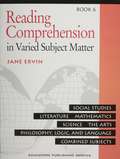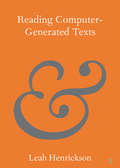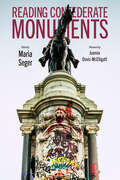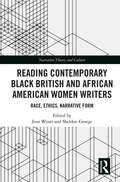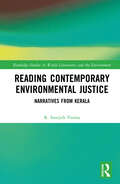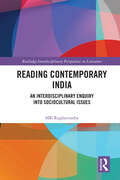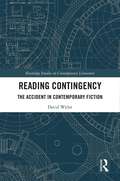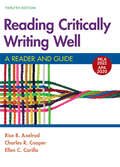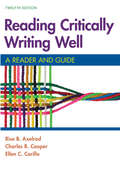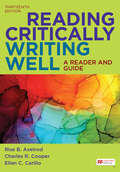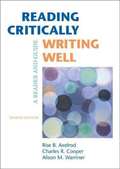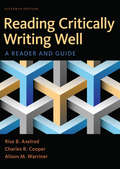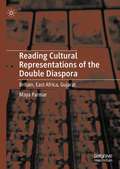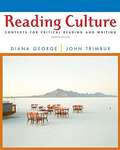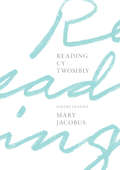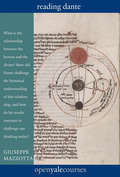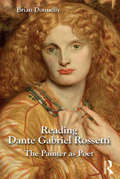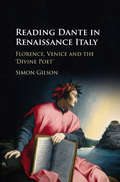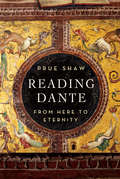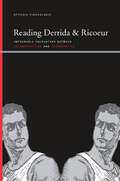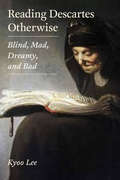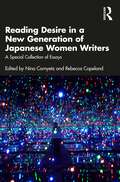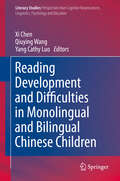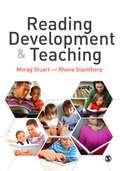- Table View
- List View
Reading Comprehension in Varied Subject Matter, Book 6 (Reading Comprehension, Erc Mrc Ser.)
by Jane ErvinThis popular series offers nonfiction reading passages with comprehension questions on a variety of subjects for students in second grade through junior high school and beyond.
Reading Comprehension through Novels
by Nancy Bruns WagnerREADING COMPREHENSION THROUGH NOVELS by Nancy Wagner
Reading Computer-Generated Texts (Elements in Publishing and Book Culture)
by Leah HenricksonNatural language generation (NLG) is the process wherein computers produce output in readable human languages. Such output takes many forms, including news articles, sports reports, prose fiction, and poetry. These computer-generated texts are often indistinguishable from human-written texts, and they are increasingly prevalent. NLG is here, and it is everywhere. However, readers are often unaware that what they are reading has been computer-generated. This Element considers how NLG conforms to and confronts traditional understandings of authorship and what it means to be a reader. It argues that conventional conceptions of authorship, as well as of reader responsibility, change in instances of NLG. What is the social value of a computer-generated text? What does NLG mean for modern writing, publishing, and reading practices? Can an NLG system be considered an author? This Element explores such question, while presenting a theoretical basis for future studies.
Reading Confederate Monuments
by Joanna Davis-McElligattContributions by Danielle Christmas, Joanna Davis-McElligatt, Garrett Bridger Gilmore, Spencer R. Herrera, Cassandra Jackson, Stacie McCormick, Maria Seger, Randi Lynn Tanglen, Brook Thomas, Michael C. Weisenburg, and Lisa Woolfork Reading Confederate Monuments addresses the urgent and vital need for scholars, educators, and the general public to be able to read and interpret the literal and cultural Confederate monuments pervading life in the contemporary United States.The literary and cultural studies scholars featured in this collection engage many different archives and methods, demonstrating how to read literal Confederate monuments as texts and in the context of the assortment of literatures that produced and celebrated them. They further explore how to read the literary texts advancing and contesting Confederate ideology in the US cultural imaginary—then and now—as monuments in and of themselves. On top of that, the essays published here lay bare the cultural and pedagogical work of Confederate monuments and counter-monuments—divulging how and what they teach their readers as communal and yet contested narratives—thereby showing why the persistence of Confederate monuments matters greatly to local and national notions of racial justice and belonging. In doing so, this collection illustrates what critics of US literature and culture can offer to ongoing scholarly and public discussions about Confederate monuments and memory. Even as we remove, relocate, and recontextualize the physical symbols of the Confederacy dotting the US landscape, the complicated histories, cultural products, and pedagogies of Confederate ideology remain embedded in the national consciousness. To disrupt and potentially dismantle these enduring narratives alongside the statues themselves, we must be able to recognize, analyze, and resist them in US life. The pieces in this collection position us to think deeply about how and why we should continue that work.
Reading Contemporary Black British and African American Women Writers: Race, Ethics, Narrative Form (Narrative Theory and Culture)
by Jean Wyatt Sheldon GeorgeContemporary African American and Black British Women Writers: Narrative, Race, Ethics brings together British and American scholars to explore how, in texts by contemporary black women writers in the U. S. and Britain, formal narrative techniques express new understandings of race or stimulate ethical thinking about race in a reader. Taken together, the essays also demonstrate that black women writers from both sides of the Atlantic borrow formal structures and literary techniques from one another to describe the workings of structural racism in the daily lives of black subjects and to provoke readers to think anew about race. Narratology has only recently begun to use race as a category of narrative theory. This collection seeks both to show the ethical effects of narrative form on individual readers and to foster reconceptualizations of narrative theory that account for the workings of race within literature and culture.
Reading Contemporary Environmental Justice: Narratives from Kerala (Routledge Studies in World Literatures and the Environment)
by R. Sreejith VarmaThis volume investigates 11 contemporary environmental justice narratives from Kerala, the south-western state in India. Introducing a detailed review of environmental literature in Malayalam, the selected eco-narratives are presented through two key literary genres: life narratives and novels, conveying the socio-environmental pressures, problems, and anxieties of modern, globalising Kerala. This text also entails primary investigations of ‘toxic fictions’ and ‘extractivist fictions,’ including Malayalam novels that narrate the disastrous consequences of the permeation of toxic pollutants in human and ecosystemic bodies, and novels that chronicle the impact of exploitative mining activities on the environment. All eco-narratives analysed in the book exhibit the familiar pattern of the Global South environmental narratives, namely, a close imbrication of the ecological and social spheres. Reading Contemporary Environmental Justice argues that these selected eco-texts offer inspiring scenarios where the subaltern people show thantedam, or courage, to claim thante idam, one’s own space in society and on the Earth. This volume will be essential for those looking to expand their understanding of environmental justice and the harmful effects of development and modernisation.
Reading Contemporary India: An Interdisciplinary Enquiry into Sociocultural Issues (Routledge Interdisciplinary Perspectives on Literature)
by MK RaghavendraThe book is the first ever attempt to examine various sociocultural aspects of contemporary India, ranging from caste and hierarchy and the religious or political conflict resulting from it to literary practice and intellectual life in the public space and making interdisciplinary associations. It does this by going back to various aspects of India’s past, stretching back several millennia to those owing to public policy after independence. Many of the issues today, such as those named above, can be traced to racial mixing through centuries, which has created a multitude of conflicts that need solutions today. The book is divided into separate chapters corresponding to the issues needing addressing, and a brief note at the conclusion of each chapter makes connections with issues dealt in other chapters. The book has an introduction tracing a significant portion of India’s past and an afterword identifying crisis areas in the present.
Reading Contingency: The Accident in Contemporary Fiction (Routledge Studies in Contemporary Literature)
by David WylotIn Reading Contingency: The Accident in Contemporary Fiction, David Wylot constructs an innovative study of the relationship between plotted accidents in twenty-first century British and American fiction, the phenomenology of reading, and a contemporary experience of time that is increasingly understood to be contingent and accidental. A synthesis of literary and cultural analysis, narratology, critical theories of time and the philosophy of contingency, the book explores the accident’s imagination of contemporary time and the relationship between reading and living in novels by writers including A.M. Homes, Nicola Barker, Noah Hawley, J.M. Coetzee, J.G. Ballard, Jesmyn Ward, Jennifer Egan, and Tom McCarthy.
Reading Critically, Writing Well with 2020 APA and 2021 MLA Updates: A Reader and Guide
by Rise B. Axelrod Charles R. Cooper Ellen CarilloThis ebook has been updated to provide you with the latest guidance on documenting sources in MLA style and follows the guidelines set forth in the MLA Handbook, 9th edition (April 2021).Reading Critically, Writing Well is a diverse collection of readings from established, emerging, and student writers, combined with expert support for writing across genres. The readings aim to inspire engaged reading, spark curious conversations, and provoke thoughtful writing. Reading Critically, Writing Well provides both the readings and the support you need to make effective rhetorical choices in your own writing.
Reading Critically, Writing Well: A Reader And Guide
by Rise Axelrod Charles Cooper Ellen CarilloWith more critical reading coverage than any other composition text, Reading Critically, Writing Well helps students read for meaning and read like a writer. A robust catalog of reading strategies complement assignment chapters that cover four expository genres, including autobiography/literacy narratives and reflection, and four argumentative genres, including evaluation and proposal. Each chapter starts with a guide to reading that challenges students to analyze the authors' techniques, and concludes with a step-by-step guide to writing and revising that helps them apply these techniques to their own essays. The provocative readings throughout represent an array of topics and disciplines. This new edition brings on noted reading scholar Ellen Carillo (University of Connecticut), and provides more opportunities for students to learn and practice complex reading and writing strategies, with a new emphasis on inquiry, curiosity, and habits of mind. Accessible instruction, engaging readings, and effective writing assignments make Reading Critically, Writing Well ideal for instructors who want to demonstrate critical analysis and the effective rhetorical choices that students can make in their own writing.
Reading Critically, Writing Well: A Reader and Guide
by Rise B. Axelrod Charles R. Cooper Ellen CarilloReading Critically, Writing Well, provides the support you need for read-writing connections to succeed in college and beyond.
Reading Critically, Writing Well: A Reader and Guide (8th edition)
by Rise B. Axelrod Charles R. Cooper Alison M. WarrinerThis book teaches you how to analyze the writing of others (both professional writers and students) and then how to apply what you learn to your own writing. For each of the eight common kinds of writing that you will be asked to do in college, ranging from autobiography and reflection to evaluation and argument, this book provides a Guide to Reading, a Guide to Writing, and six essays to serve as models.
Reading Critically, Writing Well: A Reader and Guide, 11e
by Rise B. Axelrod Charles R. Cooper Alison M. WarrinerWith more critical reading coverage than any other composition reader, Reading Critically, Writing Well helps students read for meaning and read like a writer, and it guides them to use what they've learned in their writing. Each of the book’s 8 assignment chapters includes a specific guide to reading that challenges students to analyze the authors’ techniques as well as a step-by-step guide to writing and revising that helps them apply these techniques to their own essays. Now with more readings in each chapter, including 17 provocative new professional selections and student models covering a range of disciplines, this new edition features hands-on activities for critical analysis and invention, helpful reading and research strategies (including 2016 MLA coverage), and multiple opportunities for summary and synthesis. Accessible instruction, engaging readings, and effective writing assignments make Reading Critically, Writing Well ideal for instructors who want the support and readings to demonstrate effective rhetorical choices that students can make in their own writing.
Reading Cultural Representations of the Double Diaspora: Britain, East Africa, Gujarat
by Maya ParmarReading Cultural Representations of the Double Diaspora: Britain, East Africa, Gujarat is the first detailed study of the cultural life and representations of the prolific twice-displaced Gujarati East African diaspora in contemporary Britain. An exceptional community of people, this diaspora is disproportionally successful and influential in resettlement, both in East Africa and Britain. Often showcased as an example of migrant achievement, their accomplishments are paradoxically underpinned by legacies of trauma and deracination. The diaspora, despite its economic success and considerable upward social mobility in Britain, has until now been overlooked within critical literary and postcolonial studies for a number of reasons. This book attends to that gap. Parmar uniquely investigates what it is to be not just from India, but too Africa—how identity forms within, as the study coins, the “double diaspora”. Parmar focuses on cultural representation post-twice migration, via an interdisciplinary methodology, offering new contributions to debates within diaspora studies. In doing so, the book examines a range of cultures produced amongst, or about, the diaspora, including literary representations, culinary, dance and sartorial practices, as well as visual materials.
Reading Culture: Contexts for Critical Reading and Writing
by Diana George John TrimburAcclaimed for its compelling readings and provocative images,Reading Culture provides students with outstanding instruction on how to read and write critically about the culture that surrounds them.
Reading Cy Twombly: Poetry in Paint
by Mary JacobusMany of Cy Twombly's paintings and drawings include handwritten words and phrases--naming or quoting poets ranging from Sappho, Homer, and Virgil to Mallarmé, Rilke, and Cavafy. Enigmatic and sometimes hard to decipher, these inscriptions are a distinctive feature of his work. Reading Cy Twombly poses both literary and art historical questions. How does poetic reference in largely abstract works affect their interpretation?Reading Cy Twombly is the first book to focus specifically on the artist's use of poetry. Twombly's library formed an extension of his studio and he sometimes painted with a book open in front of him. Drawing on original research in an archive that includes his paint-stained and annotated books, Mary Jacobus's account--richly illustrated with more than 125 color and black-and-white images--unlocks an important aspect of Twombly's practice.Jacobus shows that poetry was an indispensable source of reference throughout Twombly's career; as he said, he "never really separated painting and literature." Among much else, she explores the influence of Ezra Pound and Charles Olson; Twombly's fondness for Greek pastoral poetry and Virgil's Eclogues; the inspiration of the Iliad and Ovid's Metamorphoses; and Twombly's love of Keats and his collaboration with Octavio Paz.Twombly's art reveals both his distinctive relationship to poetry and his use of quotation to solve formal problems. A modern painter, he belongs in a critical tradition that goes back, by way of Roland Barthes, to Baudelaire. Reading Cy Twombly opens up fascinating new readings of some of the most important paintings and drawings of the twentieth century.
Reading Dante
by Giuseppe MazzottaA towering figure in world literature, Dante wrote his great epic poem Commedia in the early fourteenth century. The work gained universal acclaim and came to be known as La Divina Commedia, or The Divine Comedy. Giuseppe Mazzotta brings Dante and his masterpiece to life in this exploration of the man, his cultural milieu, and his endlessly fascinating works. Based on Mazzotta’s highly popular Yale course, this book offers a critical reading of The Divine Comedy and selected other works by Dante. Through an analysis of Dante’s autobiographical Vita nuova, Mazzotta establishes the poetic and political circumstances of The Divine Comedy. He situates the three sections of the poem--Inferno, Purgatory, Paradise--within the intellectual and social context of the late Middle Ages, and he explores the political, philosophical, and theological topics with which Dante was particularly concerned.
Reading Dante Gabriel Rossetti: The Painter as Poet
by Brian DonnellyA revolutionary figure throughout his career, Dante Gabriel Rossetti’s work provides a distinctly revolutionary lens through which the Victorian period can be viewed. Suggesting that Rossetti’s work should be approached through his poetry, Brian Donnelly argues that it is both inscribed by and inscribes the development of verbal as well as visual culture in the Victorian era. In his discussions of modernity, aestheticism, and material culture, he identifies Rossetti as a central figure who helped define the terms through which we approach the cultural productions of this period. Donnelly begins by articulating a method for reading Rossetti’s poetry that highlights the intertextual relations within and between the poetry and paintings. His interpretations of such poems as the 'Mary’s Girlhood' sonnets, the sonnet sequence The House of Life, and 'The Orchard-Pit' in relationship to paintings such as The Girlhood of Mary Virgin and Ecce Ancilla Domini! shed light on Victorian ideals of femininity, on consumer culture, and on the role of gender hierarchies in Victorian culture. Situating Rossetti’s poetry as the key to all of his work, Donnelly also makes a case for its centrality in its representation of the dominant discourses of the late Victorian period: faith, sex, consumption, death, and the nature of representation itself.
Reading Dante in Renaissance Italy: Florence, Venice and the 'Divine Poet'
by Simon GilsonSimon Gilson's new volume provides the first in-depth account of the critical and editorial reception in Renaissance Italy, particularly Florence, Venice and Padua, of the work of Dante Alighieri (1265-1321). Gilson investigates a range of textual frameworks and related contexts that influenced the way in which Dante's work was produced and circulated, from editing and translation to commentaries, criticism and public lectures. In so doing he modifies the received notion that Dante and his work were eclipsed during the Renaissance. Central themes of investigation include the contestation of Dante's authority as a 'classic' writer and the various forms of attack and defence employed by his detractors and partisans. The book pays close attention not only to the Divine Comedy but also to the Convivio and other of Dante's writings, and explores the ways in which the reception of these works was affected by contemporary developments in philology, literary theory, philosophy, theology, science and printing.
Reading Dante: From Here to Eternity
by Prue ShawThe best and most eloquent introduction to Dante for our time. Prue Shaw is one of the world's foremost authorities on Dante. Written with the general reader in mind, Reading Dante brings her knowledge to bear in an accessible yet expert introduction to his great poem. This is far more than an exegesis of Dante's three-part Commedia. Shaw communicates the imaginative power, the linguistic skill and the emotional intensity of Dante's poetry--the qualities that make the Commedia perhaps the greatest literary work of all time and not simply a medieval treatise on morality and religion. The book provides a graphic account of the complicated geography of Dante's version of the afterlife and a sure guide to thirteenth-century Florence and the people and places that influenced him. At the same time it offers a literary experience that lifts the reader into the universal realms of poetry and mythology, creating links not only to the classical world of Virgil and Ovid but also to modern art and poetry, the world of T. S. Eliot, Seamus Heaney and many others. Dante's questions are our questions: What is it to be a human being? How should we judge human behavior? What matters in life and in death? Reading Dante helps the reader to understand Dante's answers to these timeless questions and to see how surprisingly close they sometimes are to modern answers. Reading Dante is an astonishingly lyrical work that will appeal to both those who've never read the Commedia and those who have. It underscores Dante's belief that poetry can change human lives.
Reading Derrida and Ricoeur: Improbable Encounters between Deconstruction and Hermeneutics (SUNY series, Insinuations: Philosophy, Psychoanalysis, Literature)
by Eftichis PirovolakisWritten in the aftermath of the deaths of the French philosophers Jacques Derrida (1930-2004) and Paul Ricoeur (1913-2005), this book is an important and innovative study of the contentious relation between deconstruction and hermeneutics. Offering close readings of Derrida's and Ricoeur's writings on phenomenology, psychoanalysis, structuralist linguistics, and Levinasian ethics, Eftichis Pirovolakis introduces the motif of 'improbable encounters,' and explicates why the two thinkers may be said to be simultaneously close to each other and separated by an unbridgeable abyss. Pirovolakis complicates any facile distinction between these movements, which are two of the most influential streams of continental thought, and questions a certain pathos with respect to the distance separating them. Pirovolakis also translates Derrida's brief tribute to Ricoeur: "The Word: Giving, Naming, Calling," which appears here in English for the first time. The book is essential reading for anyone immersed in continental philosophy or literary theory.
Reading Descartes Otherwise: Blind, Mad, Dreamy, and Bad
by Kyoo LeeFocusing on the first four images of the Other mobilized in Descartes’ Meditations—namely, the blind, the mad, the dreamy, and the bad—Reading Descartes Otherwise casts light on what have heretofore been the phenomenological shadows of “Cartesian rationality.” In doing so, it discovers dynamic signs of spectral alterity lodged both at the core and on the edges of modern Cartesian subjectivity.Calling for a Copernican reorientation of the very notion “Cartesianism,” the book’s series of close, creatively critical readings of Descartes’ signature images brings the dramatic forces, moments, and scenes of the cogito into our own contemporary moment. The author patiently unravels the knotted skeins of ambiguity that have been spun within philosophical modernity out of such clichés as “Descartes, the abstract modern subject” and “Descartes, the father of modern philosophy”—a figure who is at once everywhere and nowhere. In the process, she revitalizes and reframes the legacy of Cartesian modernity, in a way more mindful of its proto-phenomenological traces.
Reading Desire in a New Generation of Japanese Women Writers: A Special Collection of Essays
by Rebecca Copeland Nina CornyetzThis book explores desire through the work of a new generation of Japanese women writers, in response to the increased attention these writers have received following the release of their work in the English language. The contributions explore a wide range of theoretical approaches and psychoanalytic interpretations to "reading" a new generation of Japanese women writers’ relationships to identity, sex/gender, and desire. Through dealing with female spaces, maternal roles, gendered bodies, or resistant speech acts, the book uncovers the overarching theme of desire – desire for language, touch, and recognition. Focusing on authors who have previously been underrepresented in English-language scholarship, the book highlights the diverse nature and the important synergies of writing by women in the last few decades. Addressing experimental and nonconforming authors whose works challenge gender and culture expectation as well as Orientalist myths, this will be a valuable resource for students and scholars of Asian literature, Japanese culture, and Asian studies.
Reading Development and Difficulties in Monolingual and Bilingual Chinese Children
by Xi Chen Qiuying Wang Yang Cathy LuoThis volume explores Chinese reading development, focusing on children in Chinese societies and bilingual Chinese-speaking children in Western societies. The book is structured around four themes: psycholinguistic study of reading, reading disability, bilingual and biliteracy development, and Chinese children's literature. It discusses issues that are pertinent to improving language and literacy development, and complex cognitive, linguistic, and socio-cultural factors that underlie language and literacy development. In addition, the book identifies instructional practices that can enhance literacy development and academic achievement. This volume offers an integrative framework of Chinese reading, and deepens our understanding of the intricate processes that underlie Chinese children's literacy development. It promotes research in reading Chinese and celebrates the distinguished and longstanding career of Richard C. Anderson.
Reading Development and Teaching (Discoveries & Explanations in Child Development)
by Morag Stuart Rhona StainthorpThis textbook will prove invaluable to teacher educators, teachers, educational psychologists, and any professional who is involved with teaching children to read. It provides a detailed examination of the processes that are involved in achieving fluent word reading skills and ability to comprehend written texts. Understanding these processes and their development empowers teachers to select appropriate, evidence-based teaching strategies and thus teach children more effectively. The book is in four parts: Part 1 provides the reader with a Tutorial Review covering essential knowledge about language, and presenting the two dimensions of the Simple View of Reading. Part 2 concentrates on the word reading dimension, with chapters on processes in skilled word reading, the development of these processes, and practical advice on research validated teaching methods to develop children’s word reading skills. Part 3 turns to the language comprehension dimension, with chapters on the comprehension of oral and written language, and on teaching reading comprehension. Part 4 introduces the reader to assessment practices and methods of identifying children with difficulties in either or both dimensions of the Simple View, and considers children with word reading difficulties and children with specific comprehension difficulties, describing effective evidence-based interventions for each type of difficulty.
